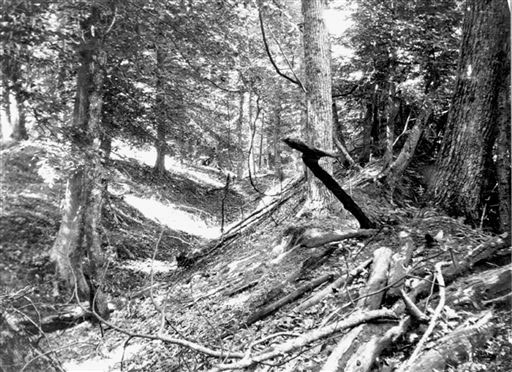Study: New Madrid fault zone alive and active

File-This undated photo provided by the United States Geological Survey shows a landslide trench and ridge east of Reelfoot Lake in Obion County, Tennessee made by the New Madrid earthquakes in the early 1800s. AP File photo.
LOS ANGELES, California—The New Madrid fault zone in the nation’s midsection is active and could spawn future large earthquakes, scientists reported Thursday.
It’s “not dead yet,” said United States Geological Survey seismologist Susan Hough, who was part of the study published online by the journal Science.
Researchers have long debated just how much of a hazard New Madrid poses. The zone stretches 150 miles (241 kilometers), crossing parts of Arkansas, Illinois, Indiana, Kentucky, Mississippi, Missouri and Tennessee.
In 1811 and 1812, it unleashed a trio of powerful jolts—measuring magnitudes 7.5 to 7.7—that rattled the central Mississippi River valley. Chimneys fell and boats capsized. Farmland sank and turned into swamps. The death toll is unknown, but experts don’t believe there were mass casualties because the region was sparsely populated then.
Unlike California’s San Andreas and other faults that occur along boundaries of shifting tectonic plates, New Madrid is less understood since it’s in the middle of the continent, far from plate boundaries.
Article continues after this advertisementPrevious studies have suggested that it may be shutting down, based on global positioning system (GPS) readings that showed little strain accumulation at the surface. Other research came to the same conclusion by blaming ongoing quake activity on aftershocks from the 1800s, which would essentially relieve strain on the fault.
Article continues after this advertisementThe latest study suggests otherwise. Hough and USGS geophysicist Morgan Page in Pasadena, California, analyzed past quakes in the New Madrid region and used computer modeling to determine that the continuing tremors are not related to the big quakes two centuries ago.
“Our new results tell us that something is going on there, and therefore a repeat of the 1811-1812 sequence is possible,” Hough said.
The USGS estimates there’s a seven to 10 percent chance of that happening in the next 50 years.
Arthur Frankel, a seismologist with the USGS in Seattle who had no role in the study, said the latest results seem plausible. His recent field work using GPS shows significant movement of land along the fault in the past decade, indicating a buildup of strain that could lead to potentially dangerous quakes.
Others said this won’t end the debate about the hazards on the New Madrid seismic zone.
Andrew Newman, a geophysicist at the Georgia Institute of Technology, said the method used in the study works well for faults along plate boundaries, but he’s unsure if it applies to enigmatic faults like New Madrid.
RELATED STORIES
New fault system could be the cause of Bohol quake—Phivolcs